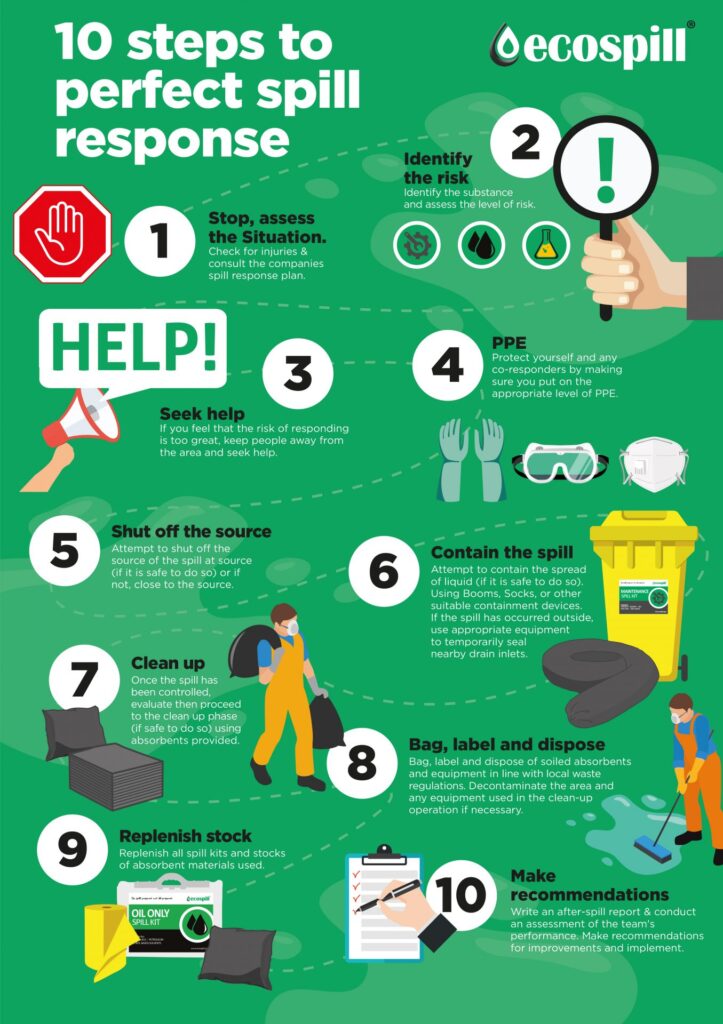What is the proper order for responding to a spill?

Spills can occur in various settings and have the potential to cause significant harm to the environment and human health. In order to minimize the impact of a spill, it is crucial to have a well-defined and systematic response plan in place. This article will outline the proper order for responding to a spill, ensuring that the necessary steps are taken to mitigate its effects.
- Understanding Spills and Their Potential Impact
- The Importance of a Proper Response
- Assessing the Situation
- Alerting the Appropriate Authorities
- Containment and Control Measures
- Implementing Cleanup Procedures
- Disposal of Contaminated Materials
- Decontamination and Restoration
- Training and Preparedness
- Conclusion
- Frequently Asked Questions
Understanding Spills and Their Potential Impact
Before delving into the response procedures, it is important to understand the nature of spills and their potential consequences. Spills can range from chemical leaks to oil spills, each requiring a specific response approach. The impact of a spill can be far-reaching, affecting ecosystems, water sources, and public health. Being aware of the potential risks associated with a spill is essential for an effective response.
The Importance of a Proper Response
A prompt and well-executed response is crucial when dealing with spills. A proper response can help minimize the spread of contaminants, reduce environmental damage, protect public health, and limit legal liabilities. It is essential for individuals and organizations to be prepared and trained in spill response procedures to ensure a swift and efficient response.
Assessing the Situation
Upon discovering a spill, the first step is to assess the situation. This involves determining the type and volume of the spilled material, as well as identifying any immediate risks or potential hazards. By assessing the situation, responders can make informed decisions regarding the appropriate course of action.
Once the situation has been assessed, the next step is to alert the appropriate authorities. This may include contacting local emergency services, environmental agencies, or regulatory bodies. Promptly notifying the relevant authorities ensures that they can provide necessary support and resources to aid in the response effort.
Containment and Control Measures
After alerting the authorities, the focus shifts to containing and controlling the spill. This involves implementing measures to prevent the spread of the spilled material and minimize further contamination. Techniques such as using barriers, absorbents, or physical containment structures can be employed to confine the spill and prevent it from entering waterways or sensitive areas.
Implementing Cleanup Procedures
Once the spill has been contained, the cleanup procedures can commence. The specific cleanup methods will depend on the type of spill and the nature of the spilled material. This may involve using specialized equipment, techniques, or chemical agents to remove or neutralize the contaminants. It is important to follow established guidelines and best practices to ensure a safe and effective cleanup.
Disposal of Contaminated Materials
Proper disposal of the contaminated materials is a critical step in the spill response process. It is important to adhere to local regulations and guidelines for the disposal of hazardous materials. This may involve coordinating with waste management authorities or licensed contractors to ensure the safe and environmentally sound disposal of the contaminated materials.
Decontamination and Restoration
After the cleanup and disposal procedures, decontamination and restoration activities can take place. This involves thoroughly cleaning and decontaminating the affected areas to remove any remaining traces of the spilled material. Additionally, steps should be taken to restore the environment to its original state, including rehabilitating any impacted ecosystems or habitats.
Training and Preparedness
Lastly, it is essential to prioritize training and preparedness for spill response. Regular training sessions should be conducted to ensure that individuals involved in spill response are familiar with the proper procedures, equipment usage, and safety protocols. Preparedness measures, such as having readily accessible spill response kits and established communication channels, can significantly enhance the effectiveness of a spill response.
Conclusion
Responding to a spill in the correct order is of utmost importance to minimize its impact and protect the environment and public health. By following the outlined sequence of steps, from assessing the situation to training and preparedness, individuals and organizations can ensure a swift and effective response to spills. Remember, proper response and preparedness are key to mitigating the potential risks associated with spills.
Frequently Asked Questions
1. What should I do immediately after discovering a spill?
After discovering a spill, the first step is to assess the situation and identify any immediate risks. This will help determine the appropriate course of action and whether it is necessary to alert the authorities.
2. How can I determine the potential risks associated with a spill?
Determining the potential risks associated with a spill involves assessing the type and volume of the spilled material, as well as its proximity to sensitive areas such as water sources or populated areas. Consulting material safety data sheets (MSDS) or seeking expert advice can also provide valuable insights into the risks involved.
3. Are there any specific regulations or guidelines to follow when responding to a spill?
Yes, there are specific regulations and guidelines that vary depending on the location and type of spill. It is important to familiarize yourself with local regulations and industry-specific guidelines to ensure compliance and a proper response.
4. What are some common mistakes to avoid during the spill response process?
Some common mistakes to avoid during the spill response process include not properly assessing the situation, failing to notify the appropriate authorities, inadequate containment measures, improper use of cleanup materials or equipment, and insufficient decontamination and restoration efforts. It is essential to follow established protocols and guidelines to minimize the potential for mistakes.

Leave a Reply